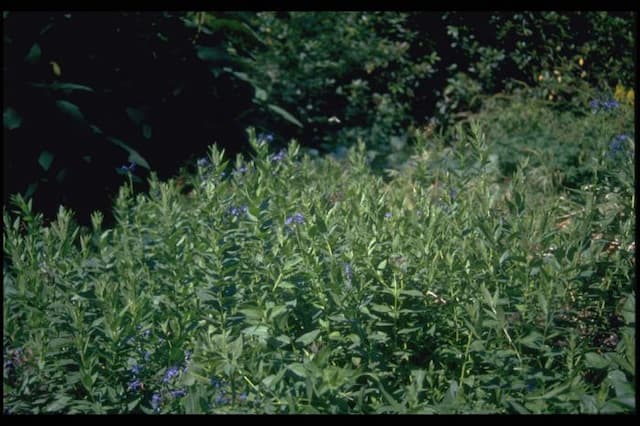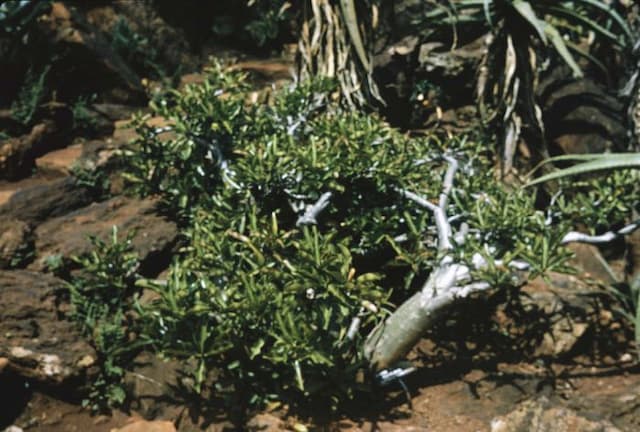Star jasmine [Star of Toscana] Trachelospermum jasminoides Star of Toscana = 'Selbra' (PBR)
![star jasmine [Star of Toscana]](/_next/image?url=https%3A%2F%2Fplants-admin.emdemapps.com%2Fimages%2Fplants%2F%2Fimages%2F604b62fa574d4.png&w=3840&q=75)
ABOUT
[Star of Toscana] is a woody, evergreen climber, to 9m tall, with narrowly oval, glossy green leaves which often turn bronze in winter. In summer, fragrant, star-shaped, pale yellow flowers, with a darker yellow centre, are borne in clusters
About this plant
 Names
NamesFamily
Apocynaceae.
Synonyms
Star of Tuscany Jasmine, Toscana False Jasmine, Tuscan Jasmine.
Common names
Rhynchospermum jasminoides, Rhynchospermum jasminoideum.
 Characteristics
CharacteristicsLife cycle
Perennials
Foliage type
Evergreen
Color of leaves
Green
Flower color
Yellow
Height
3-6 feet (0.91-1.83 meters)
Spread
3-6 feet (0.91-1.83 meters)
Plant type
Climber
Hardiness zones
8
Native area
Asia
Benefits
 General Benefits
General Benefits- Aesthetic Appeal: Star Jasmine features attractive yellowish-white flowers with a sweet fragrance, enhancing any garden ambiance.
- Evergreen Foliage: The plant retains its glossy green leaves throughout the year, providing constant beauty and coverage.
- Vertical Gardening: With its climbing habit, it can be trained on trellises or walls, maximizing vertical space in the garden.
- Low Maintenance: It requires minimal care once established, making it ideal for both novice and experienced gardeners.
- Drought Tolerance: Once established, Star Jasmine has good resistance to drought, reducing the need for frequent watering.
- Versatility: It can be used in a variety of settings, including containers, as groundcover, or as a fragrant hedge.
- Privacy Screen: When trained on fences or trellises, it can act as an attractive privacy screen or living wall.
- Wildlife Attraction: The flowers provide nectar for pollinators like bees and butterflies, supporting local ecosystems.
- Shade Tolerance: Star Jasmine can tolerate partial shade, making it suitable for planting in various light conditions.
- Soil Adaptability: It adapts to a wide range of soil types, provided they are well-drained.
 Medical Properties
Medical PropertiesThis plant is not used for medical purposes.
 Air-purifying Qualities
Air-purifying QualitiesThis plant is not specifically known for air purifying qualities.
 Other Uses
Other Uses- Photo and Film Sets: Trachelospermum jasminoides can be used to create a lush, romantic setting for photo shoots and film scenes, particularly those aiming for a Mediterranean or garden atmosphere.
- Educational Tool: This plant may serve in botanical studies as an example of plant growth habits, such as twining vines, for educational purposes in horticulture programs.
- Privacy Screening: When planted close together along a fence, Trachelospermum jasminoides can create a dense, evergreen screen, providing privacy for patios and gardens.
- Noise Reduction: The thick foliage of this plant can help dampen noise when planted along property lines in urban or suburban areas.
- Therapeutic Gardening: Engaging in the planting and tending of Trachelospermum jasminoides can be part of therapeutic garden programs, offering psychological benefits through gardening activities.
- Craft Supplies: Mature vines can be harvested and dried to create natural craft materials for wreaths, baskets, and other rustic decorations.
- Scented Garlands: The fragrant flowers can be threaded into garlands for natural air freshening in homes, event spaces, or cars without the use of artificial fragrances.
- Textile Dyeing: The plant material may potentially be utilized in the process of natural dyeing, a method to obtain colors from botanical sources for fabrics.
- Artistic Inspiration: Artists may use Trachelospermum jasminoides as a subject or inspiration for paintings, drawings, and other forms of visual art.
- Soundscaping: The rustling of the leaves in the wind can contribute to the soundscape of a garden, providing soothing background noise that enhances the sensory experience.
Interesting Facts
 Feng Shui
Feng ShuiThe Star Jasmine is not used in Feng Shui practice.
 Zodiac Sign Compitability
Zodiac Sign CompitabilityThe Star Jasmine is not used in astrology practice.
 Plant Symbolism
Plant Symbolism- Love and Affection: Trachelospermum jasminoides, commonly known as Star Jasmine, often symbolizes love and affection, as its sweet fragrance and delicate white flowers can evoke feelings of warmth and tenderness.
- Beauty: The striking beauty of the Star Jasmine's blossoms is associated with physical and inner beauty, representing an appreciation of aesthetic pleasures.
- Sensuality: The plant's intense fragrance and its habit of blooming at night connect it with sensuality and the mysteries of the evening.
- Purity: The white color of Star Jasmine's flowers is traditionally linked with purity and innocence, often used in bridal bouquets and wedding decorations.
- Good Luck: In some cultures, the Star Jasmine is considered a symbol of good luck, and having it in the home is believed to bring positive energy and prosperity.
 Water
WaterStar Jasmine should be watered deeply but infrequently, as overwatering can lead to root rot. Generally, watering once a week during the growing season is sufficient, but this may need to be adjusted depending on climate and soil conditions. Ensure the soil is dry to the touch about an inch deep before watering again. Each watering session should provide enough water to saturate the root zone—approximately one to two gallons for established plants. During winter, water less frequently, only enough to prevent the soil from drying out completely.
 Light
LightStar Jasmine thrives in full sun to partial shade. The best spot for the plant is one where it receives at least 4 to 6 hours of direct sunlight daily, while still being protected from the intense afternoon sun. An eastern or western exposure is ideal for providing the right balance of light for optimal growth and flowering.
 Temperature
TemperatureStar Jasmine performs best in temperatures ranging from 60°F to 80°F and can tolerate a minimum temperature of about 10°F, making it a reasonably cold-hardy plant. It can survive brief periods of colder temperatures but sustained freezing conditions could damage the plant. Ideally, maintain the plant in an environment where temperatures are consistently within the 60°F to 80°F range for best growth and flowering.
 Pruning
PruningStar Jasmine benefits from annual pruning to maintain its shape, encourage bushier growth, and remove dead or damaged branches. The best time for pruning is after the plant has finished blooming, usually in late summer or early fall. Pruning can be done every year, focusing on thinning out overcrowded areas to improve air circulation and cutting back long shoots to promote a compact growth habit.
 Cleaning
CleaningAs needed
 Soil
SoilThe best soil mix for Star Jasmine is well-draining with rich organic matter; a combination of potting soil, compost, and perlite is ideal. It prefers a slightly acidic to neutral pH, around 6.0 to 7.5.
 Repotting
RepottingStar Jasmine should be repotted every 2-3 years during spring, or when it becomes pot-bound.
 Humidity & Misting
Humidity & MistingStar Jasmine thrives in moderate to high humidity levels, ideally around 40-50%.
 Suitable locations
Suitable locationsIndoor
Place in bright, indirect light, and ensure good air circulation.
Outdoor
Plant in partial shade to full sun, shelter from harsh conditions.
Hardiness zone
8-10 USDA.
 Life cycle
Life cycleTrachelospermum jasminoides 'Star of Toscana', commonly known as Tuscan Jasmine, begins its life cycle as a seed, which after germination, develops into a young seedling with primary leaves. It soon enters a vegetative growth stage where it grows rapidly, establishing a strong root system and developing climbing stems and evergreen leaves. As the plant matures, it enters the flowering phase, typically in the spring and summer months, producing fragrant, creamy yellow flowers that attract pollinators such as bees and butterflies. After pollination, flowers may develop into small, bean-like seed pods that contain seeds for the next generation. Over time, the plant may undergo periods of dormancy, particularly in colder climates where growth slows during the fall and winter. Throughout its life, Tuscan Jasmine requires pruning to maintain shape, control growth, and encourage healthier flowering cycles, representing a maintenance stage in its life cycle.
 Propogation
PropogationPropogation time
Spring-Early Summer
Propogation: The most popular method of propagating Trachelospermum jasminoides, commonly known as Star Jasmine, is by semi-hardwood cuttings. This process is best carried out during the summer when the plant's growth is active. To propagate Star Jasmine by cuttings, one should select a healthy, semi-hardwood stem—that is, a stem that is not the newest, green shoot, but one that has started to mature and turn woody. Several inches (approximately 10 centimeters) long, the stem should be cut just below a leaf node, and all but a couple of leaves should be removed from the top. The cut end is often dipped in a rooting hormone to increase the odds of successful root development before being placed in a well-draining potting mix. The cutting should be kept moist and in a warm, shaded place until roots have developed, which can take several weeks. Once the cutting shows signs of growth, indicating that roots have established, it can be gradually acclimatized to more light before eventually being potted on or planted out.









